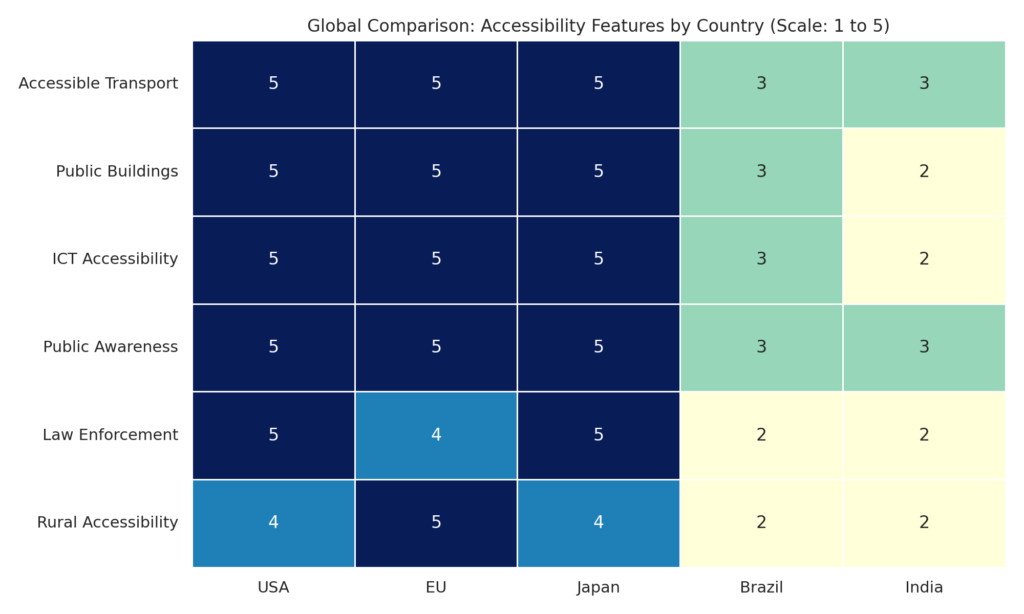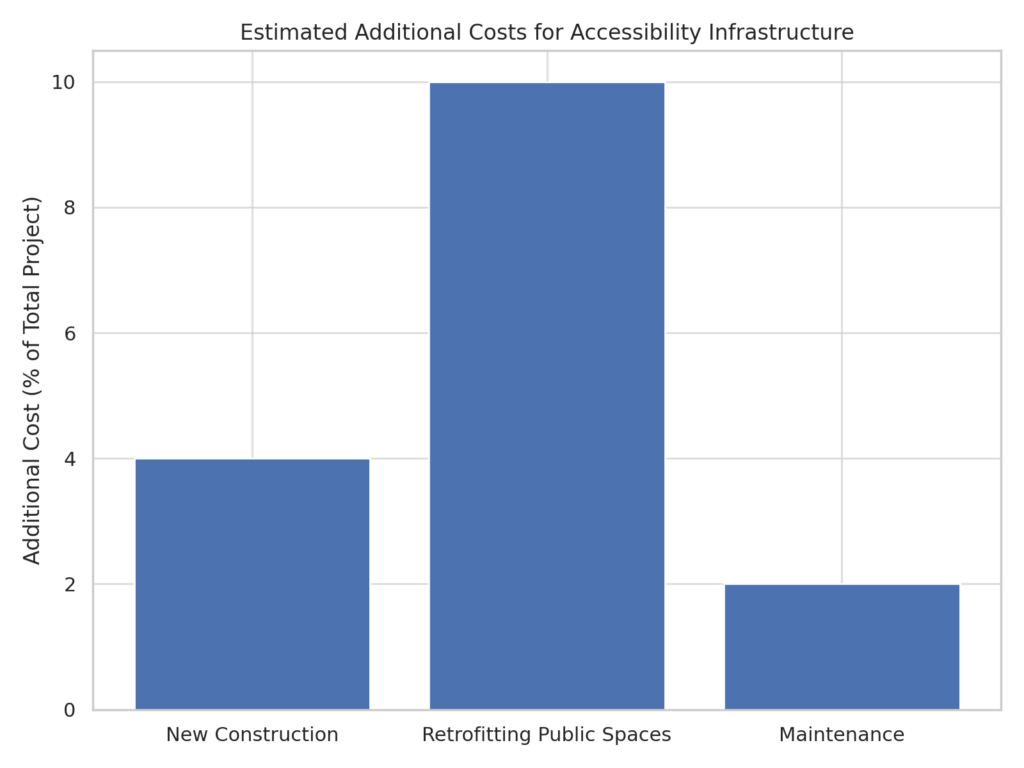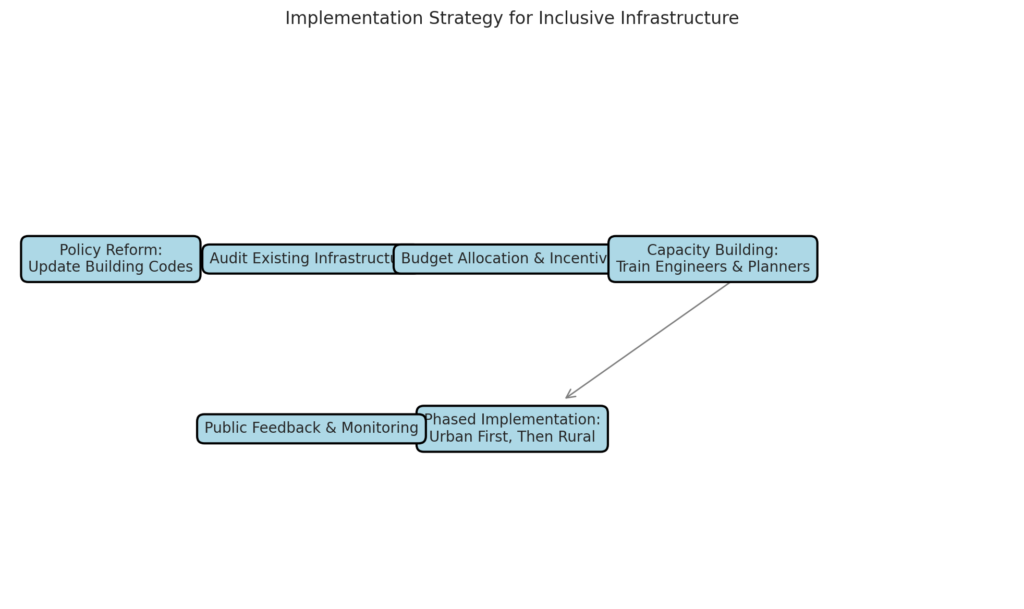Differently Abled & Senior Citizens Friendly Infrastructure: Global Best Practices and India’s Status
Introduction
As societies age and urbanize, the demand for inclusive infrastructure that addresses the needs of the differently abled and senior citizens has become not just a moral imperative but also an economic and social necessity. A truly inclusive built environment enables mobility, independence, dignity, and participation in public life. This article explores global best practices, India’s current status, building code modifications, associated costs, and the mindset shift required to make accessibility a reality across India.
1. Understanding the Needs of Differently Abled and Senior Citizens
a. Who Are We Talking About?
- Differently Abled: Includes people with physical disabilities (mobility, vision, hearing, cognitive impairments).
- Senior Citizens: Persons aged 60 and above, often dealing with reduced strength, vision, hearing, and mobility.
b. Key Needs:
- Physical Accessibility: Ramps, elevators, wide doors, handrails.
- Information Access: Braille signage, auditory announcements, clear digital interfaces.
- Transport Accessibility: Low-floor buses, kneeling features, reserved seating.
- Comfort Amenities: Public seating, shade, clean toilets.
- Safety & Navigation: Tactile paths, emergency call buttons, pedestrian safety measures.
2. Best Practices in Developed Countries
a. United States
- ADA (Americans with Disabilities Act) mandates full accessibility in transport, infrastructure, digital platforms, and services.
- Accessible voting booths, ramps, Braille-equipped ATMs, and public transport with boarding assistance.
b. Japan
- Barrier-Free Law mandates tactile paving, accessible stations, talking traffic lights, and toilets with adult changing tables.
- Trains and buses are universally accessible with trained staff for assistance.
c. European Union
- European Accessibility Act harmonizes standards across member states.
- Real-time transit aids, integrated navigation apps, senior-friendly city design, and multilingual communication systems.
3. Best Practices in Developing Countries
a. Brazil
- Strong constitutional rights for people with disabilities.
- São Paulo Metro offers Braille signage, elevators, and dedicated assistance.
b. South Africa
- Accessibility in housing and public buildings post-apartheid.
- Active NGO participation in retrofitting community spaces.
c. Thailand
- National Universal Design Strategy.
- Bangkok MRT increasingly accessible for wheelchair users and seniors.
4. Status of Friendly Infrastructure in India
a. Policy Landscape
- Rights of Persons with Disabilities Act, 2016
- Accessible India Campaign (Sugamya Bharat Abhiyan)
- National Building Code (2016): Suggests accessible design, but not mandatory across states.
- Senior Citizens Act, 2007
b. Need to Modify Building Codes
- All new residential, commercial, and institutional buildings should mandatorily include:
- Ramps with handrails
- Elevators with Braille and audio alerts
- Wide corridors and doorways
- Grab bars in restrooms
- Reserved parking
- A time-bound retrofitting program (5–10 years) for all publicly accessible spaces must be rolled out.
5. Key Components of Inclusive Infrastructure
| Infrastructure Area | Accessibility Features |
| Transport | Low-floor buses, ramps, reserved seating |
| Buildings | Elevators with Braille, wide doors, accessible toilets |
| Urban Design | Tactile paving, auditory pedestrian signals |
| ICT | Voice-guided systems, screen readers, accessible kiosks |
| Signage and Info | Braille, multilingual, pictorial |
| Amenities | Benches, shelters, clean toilets |
6. Global Benchmark Comparison
Global Comparison: Accessibility Features by Country (Scale 1–5)

7. Cost of Making Infrastructure Accessible
Estimated Additional Costs (% of Project Cost)

- New Construction: ~3–5%
- Retrofitting Existing Structures: ~5–15%
- Annual Maintenance: ~2% incremental
Despite perceptions, costs are modest relative to the benefits of inclusivity and long-term savings from reducing dependency.
8. Economic, Social, and Moral Imperatives
a. Economic Case
- Enhanced labour force participation.
- Accessible tourism and public services drive growth.
- Real estate with inclusive design has higher value and broader marketability.
b. Social Case
- Improved mental health, dignity, and social integration.
- Reduces caregiver burden, enabling families to be more productive.
c. Mindset Change – The Most Critical Factor
- Accessibility must shift from being seen as an act of charity to a basic right.
- Builders, planners, and authorities must understand universal design as aspirational and future-proof.
- Inclusive design should be part of academic curriculum in architecture and engineering.
- Community engagement and public rating of spaces can enforce accountability.
9. Technology and Innovation in Accessibility
- Smart wheelchairs with navigation and IoT
- Apps like Voice Vision, RightHear, and MapMyIndia integrated with location-based assistance
- Auditory traffic signals, digital kiosks, Braille e-book readers
- Public transport using real-time tracking and audio-visual announcements
10. Phased Implementation Timeline for India

| Timeline | Focus Area |
| Year 1–2 | Govt Buildings |
| Year 3–4 | Transport Hubs & Schools |
| Year 5+ | Private & Rural Infrastructure |
11. Universal Design Checklist
Here are recommended features and where they must be applied:
| Infrastructure Feature | Recommended For |
| Ramps with Handrails | All Buildings |
| Elevators with Braille Buttons | Multi-storey Structures |
| Wide Doors | Entryways and Public Buildings |
| Accessible Toilets | All Public & Private Toilets |
| Tactile Paving | Sidewalks and Pathways |
| Auditory Crosswalk Signals | Urban Intersections |
| Reserved Parking | Commercial Areas & Institutions |
| Resting Benches | Parks, Bus Stops, Markets |
| Multilingual Signage | Tourist and Civic Spaces |
DATA TABLE 2: Universal Design Checklist
Suggested Caption:
“Checklist for Universal Design: Features and Recommended Application Areas”
Insert After Section:
Section 11 – Universal Design Checklist
Re-insert this table manually as follows:
| Infrastructure Feature | Recommended For |
| Ramps with Handrails | All Buildings |
| Elevators with Braille Buttons | Multi-storey Structures |
| Wide Doors | Entryways and Public Buildings |
| Accessible Toilets | All Public & Private Toilets |
| Tactile Paving | Sidewalks and Pathways |
| Auditory Crosswalk Signals | Urban Intersections |
| Reserved Parking | Commercial Areas & Institutions |
| Resting Benches | Parks, Bus Stops, Markets |
| Multilingual Signage | Tourist and Civic Spaces |
12. Recommendations for India
a. Infrastructure Improvements
- Make accessibility mandatory via revised National Building Code.
- Fund a nationwide retrofitting mission with deadlines.
b. Policy & Enforcement
- Performance-based funding to states.
- Accessibility audits before granting completion/occupancy certificates.
c. Funding & Incentives
- Corporate CSR, PPP models, and municipal bonds to fund upgrades.
- Incentives for inclusive design: tax rebates, fast-track approvals.
d. Capacity Building
- Training for urban local bodies, architects, planners.
- Include universal design in academic programs.
New Infographic Added:
Title: Implementation Strategy for Inclusive Infrastructure
Filename: inclusive_infra_strategy_workflow.png
Suggested Placement: After Section 12 – Recommendations for India, just before Future Outlook.
Caption:
“Step-by-step implementation plan for rolling out accessible infrastructure across India, from policy reform to on-ground monitoring.”
13. Future Outlook: India’s Path Forward
a. Ageing Population
By 2050, 1 in 5 Indians will be above 60. Investing now in accessibility prepares India for its own demographic transition.
b. Smart Cities and Rural Integration
- Smart Cities must include inclusive mobility and digital platforms.
- Leverage MGNREGA and rural housing schemes for inclusive rural design.
c. Digital India and AI
- Integrate AI-driven interfaces in government apps and services.
- Voice and Braille-enabled access to public services should be standard.
Conclusion
India has made legislative and policy strides, but the ground reality of inclusive infrastructure remains patchy and urban-centric. A combination of revised building codes, phased retrofitting, technology adoption, and above all, a mindset shift, is required to truly empower millions of Indians with disabilities and ageing challenges. Accessibility is not a luxury or an afterthought—it is an essential foundation of a fair, equitable, and forward-looking society.
References
- Ministry of Social Justice and Empowerment – RPWD Act, 2016
- Accessible India Campaign – https://disabilityaffairs.gov.in
- UN Convention on the Rights of Persons with Disabilities
- ADA Guidelines – www.ada.gov
- WHO Global Age-Friendly Cities Guide
- National Building Code of India (NBC 2016)
- Indian Railways Accessibility Report (2023)
- European Accessibility Act
- Japan’s Basic Act for Persons with Disabilities
- National Institute for Urban Affairs (NIUA) Reports